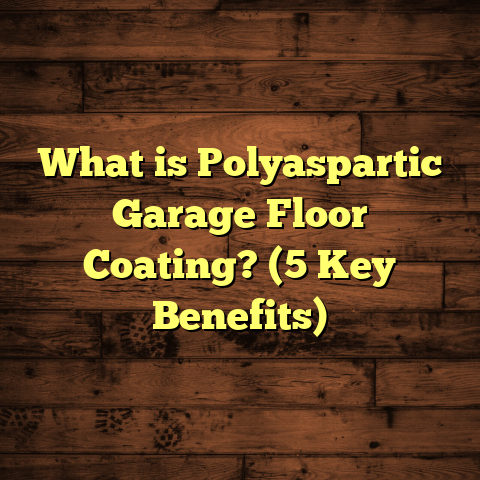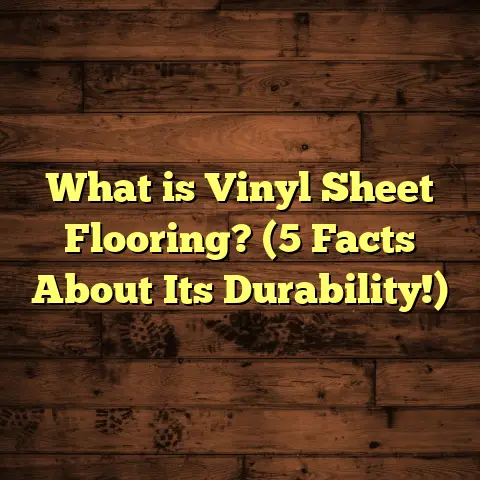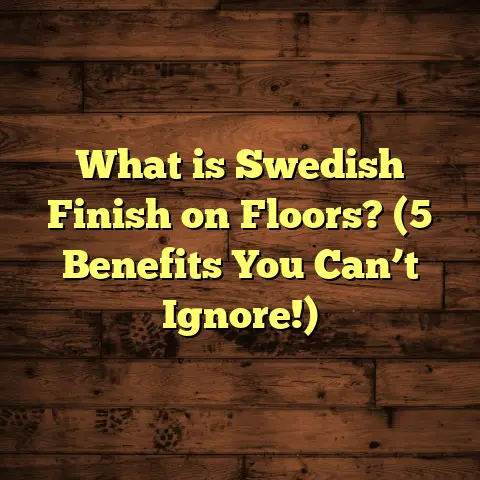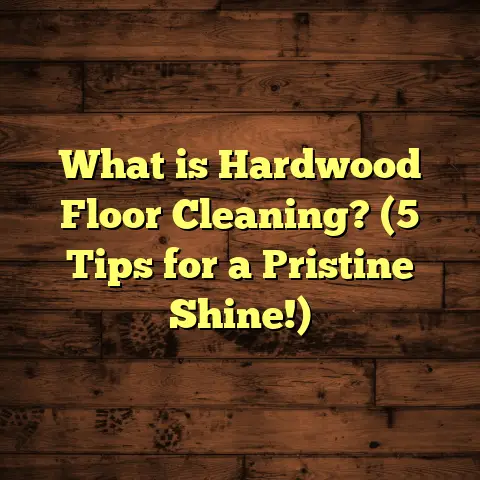What is Self-Leveling Epoxy Flooring? (5 Benefits for Your Home)
Have you ever walked into a room and felt the floor beneath your feet was more than just a surface? I have many times. Sometimes a floor doesn’t just support your steps; it tells a story about the space, the lifestyle, even the care and thought poured into the home. One type of flooring that consistently surprises me with its blend of beauty, strength, and practicality is self-leveling epoxy flooring. If you haven’t heard much about it or are wondering if it’s worth considering for your home, stick with me—I’ve got a lot to share.
What is Self-Leveling Epoxy Flooring?
So, what exactly is self-leveling epoxy flooring?
At its core, self-leveling epoxy flooring is a coating system made from epoxy resin that naturally flows and levels itself out when poured onto a floor surface. Unlike traditional coatings that require manual spreading or troweling, this epoxy has a fluid consistency that fills cracks, smooths uneven areas, and hardens into a seamless, glossy finish.
Epoxy itself is a type of polymer known for its strong adhesive properties and chemical resistance. When mixed with a hardening agent or catalyst, it undergoes a chemical reaction called curing. This process transforms the liquid resin into a solid plastic layer that bonds tightly to concrete or other substrates.
The “self-leveling” term means the epoxy can spread across the floor evenly due to its viscosity without needing much manual intervention. This feature is especially useful for fixing uneven concrete floors or covering imperfections without extensive prep work.
Why Does This Matter?
If you’ve ever dealt with cracked or pitted concrete floors at home or in your garage, you know how frustrating it is to find a flooring solution that hides imperfections while offering durability. Self-leveling epoxy effectively acts as both a repair layer and a final finish. It fills low spots and cracks during application and leaves behind a flat surface that looks polished and professional.
I remember working on an older home where the basement floor had several cracks and uneven patches. Instead of removing the concrete or installing expensive tile over a bumpy surface, we applied self-leveling epoxy. The liquid epoxy flowed into every nook and cranny and cured into a perfectly smooth surface within 24 hours. The homeowners were amazed at how their once rough basement floor transformed into something sleek and easy to clean.
The Chemistry Behind It
Epoxy resins are made by combining two components: resin and hardener. When mixed in precise ratios, they chemically react to form a rigid, durable polymer network.
The self-leveling variety contains additives that control viscosity—making it fluid enough to spread evenly yet thick enough to stay put without running off vertical surfaces.
The curing time varies depending on manufacturer formulas but generally ranges from 12 to 24 hours before the floor can be walked on safely.
5 Benefits of Self-Leveling Epoxy Flooring for Your Home
You might wonder why I’m so passionate about this flooring type. I’ve worked on numerous projects and witnessed firsthand how self-leveling epoxy can transform spaces both visually and functionally. Here are five benefits that have stood out to me over time.
1. Durability That Lasts: Tough Floors for Real Life
Durability is one of the biggest reasons I recommend self-leveling epoxy to homeowners looking for long-term flooring solutions.
Once cured, epoxy floors become incredibly hard and resistant to wear. They can withstand impacts, heavy foot traffic, abrasions, chemicals, oils, and stains far better than many traditional flooring materials.
Here’s some data to put this in perspective:
- Epoxy coatings have an abrasion resistance index up to 10 times greater than bare concrete.
- Chemical resistance tests show epoxy can resist common household chemicals including detergents, solvents, acids (within limits), and oils.
- Hardness ratings (measured by Shore D) for cured epoxy often exceed 70-80 points — indicating high scratch resistance.
This durability means your floor won’t just look good initially—it will maintain its appearance for years without chipping or fading.
I recall one garage renovation where the owner was skeptical about epoxy durability. Six months after installation, his car tires left no marks despite repeated use. He told me he was impressed how easy it was to clean oil drips with just soap and water.
2. Seamless Surface Makes Cleaning a Breeze
One of the best things about self-leveling epoxy is its seamless finish. Unlike tile or wood floors that have grout lines or joints where dirt hides, epoxy creates one continuous surface. This makes cleaning so much easier—you can simply mop or wipe without worrying about grime buildup in tiny crevices.
This is especially handy for busy families or pet owners. Spills don’t soak in; dust and allergens have nowhere to accumulate.
In my experience working with clients who have kids or pets, this benefit often surprises them the most. A mother once told me her self-leveling epoxy kitchen floor cut cleaning time in half compared to their old tile floor where grout lines stained quickly.
3. Aesthetic Flexibility: More Than Just Gray Floors
Many people picture epoxy floors as just industrial gray coatings like you see in warehouses or garages. But self-leveling epoxy offers incredible customization options that allow you to create floors matching any style or vibe.
You can choose from:
- Solid colors (neutrals like beige or bold colors)
- Metallic pigments that create swirling patterns mimicking marble or metal
- Decorative flakes embedded within clear epoxy for texture
- Custom logos or designs embedded below clear coats
One project I loved was a basement recreation room where we used metallic blue epoxy with silver flakes. The effect looked almost like liquid water shimmering under lights—it added character far beyond typical flooring choices.
Manufacturers now offer hundreds of color choices and additives to match nearly any décor theme.
4. Moisture & Chemical Resistance: Great for Basements & Laundry Areas
Concrete floors are notorious for moisture issues—especially basements or laundry rooms where humidity is higher. Moisture can cause mold growth or damage certain flooring types like hardwood or laminate.
Because self-leveling epoxy cures into a non-porous barrier, it stops moisture from penetrating through the floor surface. This helps protect your subfloor and reduce humidity-related problems.
Plus, epoxy’s chemical resistance means common household substances like detergents, oils, paint solvents won’t degrade the surface over time.
In one multi-family building I worked on, clients who switched from vinyl to epoxy basement floors reported fewer mold problems after two years because moisture was no longer seeping through cracks in old flooring.
5. Fast Installation Saves Time & Hassle
If you’ve ever dealt with remodeling projects that drag on forever, you’ll appreciate how quick self-leveling epoxy installation can be.
Once you prep your floor (cleaning and priming), pouring the epoxy typically takes just a few minutes per room. The material then flows out evenly without needing extra spreading tools.
After curing—usually 12 to 24 hours—you’re ready to use the space again.
Compared with tearing out old flooring and installing tile or hardwood (which might take several days including drying times), epoxy gets you back on your feet faster.
From my own jobs, I estimate about 1 day total for installation vs multiple days for other options.
Cost Considerations & Using FloorTally
Regarding cost estimation: flooring projects often involve juggling material prices, labor rates, size of areas, and waste factors. For my own projects, I rely on tools like FloorTally to quickly generate accurate estimates based on local market data.
This tool helps me input room dimensions, select specific materials (like self-leveling epoxy), add labor cost variables, and even account for extra material required due to waste—all consolidated into one platform.
It saves me from chasing multiple quotes or making rough guesses—and helps communicate clear budgets to clients upfront.
Typically, self-leveling epoxy installation costs range from $3 to $12 per square foot depending on product quality and complexity—but FloorTally gives me confidence in precise breakdowns tailored to each project’s location.
How I Approach Installing Self-Leveling Epoxy Floors
If you ever want to try this yourself or understand what professionals do behind the scenes, here’s an overview of my typical installation process:
Step 1: Surface Preparation
Preparation is everything with flooring. The substrate must be clean, dry, and free from dust, grease, or previous coatings.
I spend significant time grinding down rough patches and repairing cracks with patch compounds so the surface is structurally sound before applying primer and epoxy.
Humidity levels also get tested because too much moisture can affect adhesion.
Step 2: Priming
Primers help the epoxy bond better with concrete and seal porous surfaces to prevent air bubbles during curing.
I apply primer evenly with rollers and let it dry completely before moving on.
Step 3: Mixing Epoxy Components
Mix resin with hardener according to manufacturer guidelines—usually precise ratios like 2:1 by volume—to activate curing chemistry.
Timing here is critical because once mixed, you have only about 20-30 minutes before the epoxy starts thickening.
Step 4: Pouring & Spreading
Pour the mixed epoxy onto the floor starting at one corner. Thanks to its fluidity, it spreads out naturally filling low spots.
Sometimes I use a gauge rake to assist even flow but typically minimal spreading is needed with self-leveling formulas.
Step 5: Curing
Leave the floor undisturbed for at least 12 hours (or as recommended). Avoid walking on it until fully cured; otherwise surface defects may occur.
Step 6: Optional Topcoat Application
For extra protection or specific finishes (matte vs glossy), some projects get an additional clear topcoat layer after curing.
Maintaining Your Self-Leveling Epoxy Floor
Keeping your epoxy floors looking fresh requires surprisingly little effort compared to other options.
Routine Cleaning
Just mop regularly using mild detergents or pH-neutral cleaners. Avoid harsh abrasives which could dull the shine over time.
Spills wipe up easily—no staining worries if cleaned promptly.
Avoid Sharp Objects
Though epoxy is tough, dragging heavy furniture with sharp legs might scratch it. Use felt pads under chair legs or furniture sliders when moving items around.
Repair Minor Damage
If chips or cracks do appear after years (rare but possible if heavy impacts happen), small sections can be spot repaired with touch-up kits available from suppliers.
Real Client Stories & Case Studies
Let me share some real-world examples from my work over the past decade applying self-leveling epoxy floors:
Case Study 1: Family Kitchen Renovation in Chicago
The family wanted modern aesthetics plus easy maintenance for their busy kitchen where kids often spilled drinks and food messes were common.
We used light gray self-leveling epoxy mixed with decorative flakes for subtle texture that hid dirt while keeping brightness high.
Result? The homeowners reported much less time spent scrubbing floors and loved how their kitchen felt more spacious thanks to reflective flooring surfaces.
Case Study 2: Home Gym Flooring in Austin
A client wanted heavy-duty flooring able to withstand weights dropping plus sweat/moisture from workouts.
The self-leveling epoxy provided slip resistance when combined with anti-slip additives while resisting chemical damage from cleaning agents used frequently in gyms.
The client noted zero signs of wear after six months of intense use—a big upgrade from their old rubber mats which deteriorated quickly.
Case Study 3: Basement Entertainment Room in New York City
For an unfinished basement prone to slight moisture issues but eager for stylish flooring without carpet dust concerns:
We installed moisture-resistant self-leveling epoxy tinted dark charcoal with metallic effects creating a cozy yet modern vibe suitable for movie nights and parties alike.
The family complimented how easy cleanup was after spills during gatherings compared to previous carpets that trapped allergens causing discomfort to guests with allergies.
Common Questions About Self-Leveling Epoxy Flooring
Here are some questions I often get asked:
Q: Can I install self-leveling epoxy over existing flooring?
A: It depends on what’s underneath. Concrete is ideal; wood or tile may require removal or special primers. Testing adhesion before full application is key.
Q: How long does self-leveling epoxy last?
A: With proper care, expect 10-20 years of service life before resurfacing might be needed depending on traffic intensity.
Q: Is it slippery when wet?
A: Pure glossy epoxy can be slippery; adding anti-slip additives during installation improves traction without compromising appearance.
Q: Can I apply this myself?
A: DIY kits exist but professional installation ensures proper mixing ratios, surface prep, and smooth finishes especially for larger areas or commercial use zones.
Comparing Self-Leveling Epoxy Flooring With Other Popular Options
Let’s break down how self-leveling epoxy compares head-to-head against some common choices:
| Flooring Type | Pros | Cons | Best Use Cases |
|---|---|---|---|
| Self-Leveling Epoxy | Durable; seamless; customizable; moisture-proof | Requires good prep; possible slipperiness | Garages; basements; kitchens; gyms |
| Hardwood | Warm look; natural aesthetics | Prone to scratches; moisture sensitive | Living rooms; bedrooms |
| Laminate | Affordable; easy install | Less durable; vulnerable to water | Budget-friendly homes; rentals |
| Tile | Moisture-resistant; versatile designs | Grout maintenance; cold underfoot | Bathrooms; kitchens |
| Carpet | Soft underfoot; noise reduction | Stains easily; allergens | Bedrooms; living areas |
This comparison highlights why many homeowners choose self-leveling epoxy as a practical alternative when durability and ease of maintenance top priorities without sacrificing style possibilities.
Final Thoughts
Every home has unique needs when it comes to flooring choices. Over my years working hands-on with materials like self-leveling epoxy, I’ve seen how it fits perfectly where toughness meets beauty meets easy upkeep.
If you want floors that resist life’s daily chaos—kids dropping snacks, pets tracking mud, spills in laundry rooms—but still want something stylish underfoot that brightens your space—you might want to give self-leveling epoxy serious thought.
And if budgeting worries hold you back like they did me initially on my first epoxy job, tools like FloorTally help clear up uncertainties by providing tailored cost estimates quickly based on local rates and material choices. That way you know exactly what investment looks like before committing—and avoid surprises later on.
So next time you think about upgrading floors in your home—whether it’s your garage, basement rec room, kitchen area or even home gym—consider how this coating technology could change not only how your space looks but how it feels day after day underfoot.





